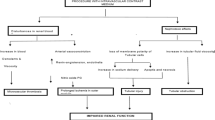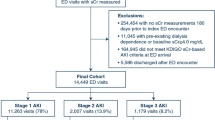Abstract
Background
More than 380,000 angiographic procedures are performed every year in Italian hospitals, with an increase rate of 8% per year. Although contrast media (CM) are considered relatively safe, adverse drug reactions (ADRs) remain an important issue.
Objectives
The objective of this study was to quantify the incidence of immediate and delayed nonrenal ADRs to iodinated CM in an Italian cohort and to evaluate whether their different physicochemical properties are able to affect the incidence of immediate or delayed ADRs.
Methods
A prospective intensive monitoring study was conducted on a cohort of patients undergoing radiodiagnostic procedures with iodinated CM enrolled in two hospitals in Tuscany, Italy. To evaluate both immediate (within 1 h after CM administration) and delayed (>1 h to 1 week after CM administration) ADRs to CM, two questionnaires were administered. Adverse events (AEs) were analyzed to check the causality assessment between CM and ADR. If more than one symptom occurred in the same patient, they were treated as a single event.
Results
One thousand five hundred and fourteen subjects who were exposed to iodinated CM completed the questionnaires. Mean age [standard deviation (SD)] was 65.4 (13.3) years, and 57.9% were male patients. A total of 178 [11.8%; 95% confidence interval (CI) 10.1–13.4] ADRs were reported. Thirty-four (2.2%; 1.5–3.1) and 144 (9.5%; 8.0–11.1) developed immediate and delayed ADRs, respectively. Both types of ADRs were experienced by six subjects (0.4%; 0.1–0.8). One hundred and seventy-six cases (98.8%; 96.0–99.8) were classified as possible and two (1.1%; 0.1–3.9) as probable ADRs. Monomeric low-osmolal (iopromide, iomeprol, iobitridol) and dimeric iso-osmolal (iodixanol) groups mainly reported delayed allergy-like ADRs of mild severity. Only one immediate reaction was severe. Multivariate analysis confirmed a higher risk of immediate reactions occurring for monomeric CM (OR 4.3; 95% CI 1.2–15.7), whereas the risk of delayed ADRs was significantly higher for the dimeric group (OR 1.8; 1.1–2.5).
Conclusions
Monomeric CM were more frequently involved in immediate ADRs, whereas dimeric CM were involved in delayed reactions. Although severe life-threatening ADRs to CM were confirmed to be rare, due to the large use of these drugs, they still retain clinical and epidemiological significance.
Similar content being viewed by others
References
Lasser EC (2004) Anaphylaxis. Novartis Found Symp 257:211–225
Persson PB (2005) Editorial: contrast medium-induced nephropathy. Nephrol Dial Transplant 20(Suppl 1):i1
Sangiorgi G (2003) Mezzi di contrasto e safety renale-cardiaca nel laboratorio di emodinamica. Emodinamica 89(9):990–992
Katayama H, Yamaguchi K, Kozuka T, Takashima T, Seez P, Matsuura K (1990) Adverse reactions to ionic and nonionic contrast media. A report from the Japanese Committee on the Safety of Contrast Media. Radiology 175(3):621–628
Almen T (1994) The etiology of contrast medium reactions. Invest Radiol 29(1):S37–S45
Brockow K, Christiansen C, Kanny G, Clement O, Barbaud A, Bircher A, Dewachter P, Gueant JL, Rodriguez Gueant RM, Mouton-Faivre C, Ring J, Romano A, Sainte-Laudy J, Demoly P, Pichler WJ (2005) Management of hypersensitivity reactions to iodinated contrast media. Allergy 60(2):150–158
Meth MJ Maibach HI (2006) Current understanding of contrast media reactions and implications for clinical management. Drug Safety 29(2):133–141
Schild HH, Kuhl CK, Hubner-Steiner U, Bohm I, Speck U (2006) Adverse events after unenhanced and monomeric and dimeric contrast-enhanced CT: a prospective randomized controlled trial. Radiology 240(1):56–64
Sutton AG, Finn P, Grech ED, Hall JA, Stewart MJ, Davies A, De Belder MA (2001) Early and late reactions after the use of iopamidol 340, ioxaglate 320, and iodixanol 320 in cardiac catheterization. Am Heart J 141(4):677–683
Sutton AG, Finn P, Campbell PG, Price DJ, Hall JA, Stewart MJ, Davies A, Linker NJ, De Belder MA (2003) Early and late reactions following the use of iopamidol 340, iomeprol 350 and iodixanol 320 in cardiac catheterization. J Invasive Cardiol 15(3):133–138
Idee JM, Pines E, Prigent P, Corot C (2005) Allergy-like reactions to iodinated contrast agents. A critical analysis. Fundam Clin Pharmacol 19(3):263–281
Morcos SK (2003) Review article: Effects of radiographic contrast media on the lung. Br J Radiol 76(905):290–295
Webb JA, Stacul F, Thomsen HS, Morcos SK (2003) Late adverse reactions to intravascular iodinated contrast media. Eur Radiol 13(1):181–184
Thomsen HS (2006) European Society of Urogenital Radiology (ESUR) guidelines on the safe use of iodinated contrast media. Eur J Radiol 60(3):307–313
Mortelé KJ, Oliva MR, Ondategui S, Ros PR, Silverman SG (2005) Universal use of nonionic iodinated contrast medium for CT: evaluation of safety in a large urban teaching hospital. AJR Am J Roentgenol 184(1):31–34
Morcos SK (2005) Review article: Acute serious and fatal reactions to contrast media: our current understanding. Br J Radiol 78(932):686–693
Dawson P (2006) Adverse reactions to intravascular contrast agents. BMJ 333(7570):663–664
Tramèr MR, von Elm E, Loubeyre P, Hauser C (2006) Pharmacological prevention of serious anaphylactic reactions due to iodinated contrast media: systematic review. BMJ 333(7570):675–680
Olsson S (1998) The role of the WHO programme on International Drug Monitoring in coordinating worldwide drug safety efforts. Drug Safety 19(1):1–10
Pahor M, Chrischilles EA, Guralnik JM, Brown SL, Wallace RB, Carbonin P (1994) Drug data coding and analysis in epidemiologic studies. Eur J Epidemiol 10(4):405–411
PHS-HCFA International Classification Diseases, 9th revision (1980). Public Health Service-Health Care Financing Administration, Washington DC
Naranjo CA, Busto U, Sellers EM, Sandor P, Ruiz I, Roberts EA, Janecek E, Domecq C, Greenblatt DJ (1981) A method for estimating the probability of adverse drug reactions. Clin Pharmacol Ther 30(2):239–245
Morcos SK, Thomsen HS, Webb JA (2001) Prevention of generalized reactions to contrast media: a consensus report and guidelines. Eur Radiol 11(9):1720–1728
Mikkonen R, Kontkanen T, Kivisaari L (1995) Acute and late adverse reactions to low-osmolal contrast media. Acta Radiol 36(1):72–76
Hosoya T, Yamaguchi K, Akutsu T, Mitsuhashi Y, Kondo S, Sugai Y, Adachi M (2000) Delayed adverse reactions to iodinated contrast media and their risk factors. Radiat Med 18(1):39–45
Yoshikawa H (1992) Late adverse reactions to nonionic contrast media. Radiology 183(3):737–740
Esplugas E, Cequier A, Gomez-Hospital JA, Del Blanco BG, Jara F (2002) Comparative tolerability of contrast media used for coronary interventions. Drug Safety 25(15):1079–1098
Munechika H, Hiramatsu Y, Kudo S, Sugimura K, Hamada C, Yamaguchi K, Katayama H (2003) A prospective survey of delayed adverse reactions to iohexol in urography and computed tomography. Eur Radiol 13(1):185–194
Lasser EC (2004) The radiocontrast molecule in anaphylaxis: a surprising antigen. Novartis Found Symp 257:211–224 discussion
Radhakrishnan S, Manoharan S, Fleet M (2005) Repeat survey of current practice regarding corticosteroid prophylaxis for patients at increased risk of adverse reaction to intravascular contrast agents. Clin Radiol 60(1):58–63
Drici MD, Clement N (2001) Is gender a risk factor for adverse drug reactions? The example of drug-induced long QT syndrome. Drug Safety 24(8):575–585
Lasser EC (1995) Gender risk for anaphylactoid reactions to contrast material. J Allergy Clin Immunol 96(6):1019–1020
Ansell G, Tweedie MC, West CR, Evans P, Couch L (1980) The current status of reactions to intravenous contrast media. Invest Radiol 15(6):S32–S39
Leone R, Conforti A, Venegoni M, Motola D, Moretti U, Meneghelli I, Cocci A, Sangiorgi CG, Scotto S, Montanaro N, Velo G (2005) Drug-induced anaphylaxis: case/non-case study based on an italian pharmacovigilance database. Drug Safety 28(6):547–556
Benahmed S, Picot MC, Dumas F, Demoly P (2005) Accuracy of a pharmacovigilance algorithm in diagnosing drug hypersensitivity reactions. Arch Intern Med 165(13):1500–1505
Macedo AF, Marques FB, Ribeiro CF (2006) Can decisional algorithms replace global introspection in the individual causality assessment of spontaneously reported ADRs? Drug Safety 29(8):697–702
Crowne DP, Marlowe D (1960) A new scale of social desirability independent of psychopathology. J Consult Psychol 24:349–354
Marlowe D, Crowne DP (1961) Social desirability and response to perceived situational demands. J Consult Psychol 25:109–115
Acknowledgements
This study was supported by a research grant from the nonprofit Drug Education and Investigation (DEI) Foundation (Italian Society of Pharmacology). We are very grateful to all radiologists (Prof. Natale Villari, Prof. Giovanni Capaccioli, Prof. Stefano Colagrande, Prof. Mario Mascalchi, Dr. Luigi Magi Diligenti, Dr. Gian Paolo Giordano, Dr. Paolo Simonelli, Dr. Luigi Rega, Dr. Manlio Acquafresca, Dr. Catia Dini, Dr. Gianni Pellicanò, Dr. Raffaella Giannini, Dr. Patrizio Pacini, Dr. Luca Carmignani, Dr. Davide Gadda, Dr. Andrea Pagliari, Dr. Franco Niccolai, Dr. Letizia Vannucchi, Dr. Anna Neri, Dr. Giuseppe Bellandi, Dr. Alessandro Bartolini, Dr. Leonardo Moreschi, Dr. Adriano Viviani, Dr. Enrico Ricci, Dr. Elena Zipoli, Dr. Alessandra Pagliani, Dr. Mauro Rossi, Dr. Daniele Varanini, Dr. Roberto Becherini, Dr. Antonio Giomi, Dr. Luigi Lavorini, Dr. William Vergoni), nurses (Mara Ridoni, Maria Pina Corbelli, Margherita Malavolti, Noris Bruni, Barbara Beneforti, Alberto Propati, Simonetta Aiazzi, Franco Romaniello, Sonia Chiti, Marzia Ferri, Marco Centini, Adele Nenci, Monica Guarascio, Monica Micheli), radiology technicians (Davide Tassi, Roberto Delli Ponti, Riccardo Terreni, Pierluigi Russo, Caterina Lazzerini, Luca Del Nista, Nunzio Piccolo, Donato Piccolo, Vinicio Paoletti, Alba Giaimo, Stefano Cappellini, Stefano Favelli, Piero Di Meo, Salvatore Castiglia, Alessandra Gavazzi, Rossella Nesti), and hospital pharmacists (Dr. Federico Romagnoli, Dr. Federica Mafucci, Dr. Matteo Lorenzo Lombardi, Dr. Barbara Fredducci) who took part to study planning and data collection. The authors have no conflicts of interest that are directly relevant to the content of the study.
Author information
Authors and Affiliations
Corresponding author
Appendices
Appendix 1. Questionnaire to assess possible immediate adverse events to contrast media

Appendix 2. Questionnaire to assess possible delayed adverse events due to contrast media (administered by phone or face-to-face by a trained pharmacist after checking the previously collected information on the patient, exept for possible occurrence of immediate event)

Appendix 3
Comments on patients status
A univariate analysis was performed to compare features of inpatients and outpatients: as shown in Table 6 additional characteristics to Table 1 with a significant different distribution between groups, were comorbidity, previous examination with ICM, antiasthmatic drugs, other diseases, and other drugs.
When all factors, including these additional ones, were included into a logistic model having DRs as outcome variable, analogous results were obtained for patient status (OR 1.5; 1.1–2.3, p = 0.020).
Rights and permissions
About this article
Cite this article
Lapi, F., Cecchi, E., Pedone, C. et al. Safety aspects of iodinated contrast media related to their physicochemical properties: a pharmacoepidemiology study in two Tuscany hospitals. Eur J Clin Pharmacol 64, 723–737 (2008). https://doi.org/10.1007/s00228-008-0477-7
Received:
Accepted:
Published:
Issue Date:
DOI: https://doi.org/10.1007/s00228-008-0477-7




